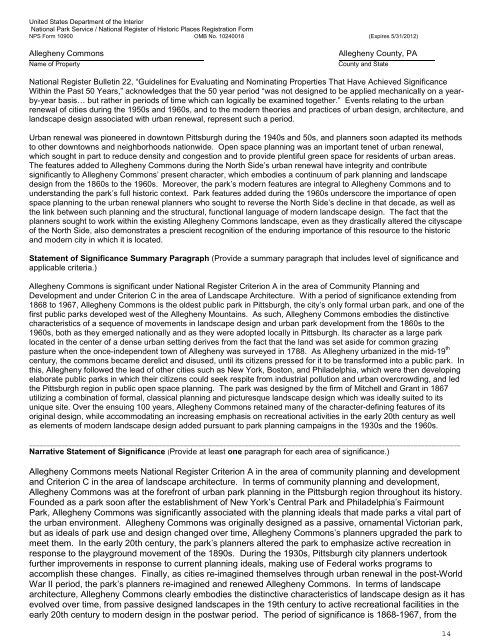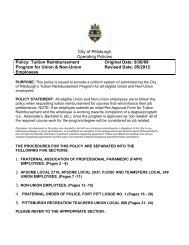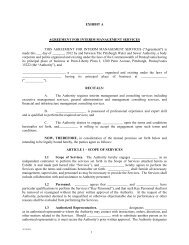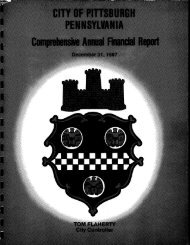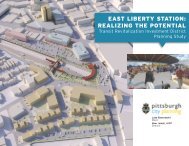Allegheny Commons - City of Pittsburgh
Allegheny Commons - City of Pittsburgh
Allegheny Commons - City of Pittsburgh
You also want an ePaper? Increase the reach of your titles
YUMPU automatically turns print PDFs into web optimized ePapers that Google loves.
United States Department <strong>of</strong> the InteriorNational Park Service / National Register <strong>of</strong> Historic Places Registration FormNPS Form 10900 OMB No. 10240018 (Expires 5/31/2012)<strong>Allegheny</strong> <strong>Commons</strong>Name <strong>of</strong> Property<strong>Allegheny</strong> County, PACounty and StateNational Register Bulletin 22, “Guidelines for Evaluating and Nominating Properties That Have Achieved SignificanceWithin the Past 50 Years,” acknowledges that the 50 year period “was not designed to be applied mechanically on a yearby-yearbasis… but rather in periods <strong>of</strong> time which can logically be examined together.” Events relating to the urbanrenewal <strong>of</strong> cities during the 1950s and 1960s, and to the modern theories and practices <strong>of</strong> urban design, architecture, andlandscape design associated with urban renewal, represent such a period.Urban renewal was pioneered in downtown <strong>Pittsburgh</strong> during the 1940s and 50s, and planners soon adapted its methodsto other downtowns and neighborhoods nationwide. Open space planning was an important tenet <strong>of</strong> urban renewal,which sought in part to reduce density and congestion and to provide plentiful green space for residents <strong>of</strong> urban areas.The features added to <strong>Allegheny</strong> <strong>Commons</strong> during the North Side’s urban renewal have integrity and contributesignificantly to <strong>Allegheny</strong> <strong>Commons</strong>’ present character, which embodies a continuum <strong>of</strong> park planning and landscapedesign from the 1860s to the 1960s. Moreover, the park’s modern features are integral to <strong>Allegheny</strong> <strong>Commons</strong> and tounderstanding the park’s full historic context. Park features added during the 1960s underscore the importance <strong>of</strong> openspace planning to the urban renewal planners who sought to reverse the North Side’s decline in that decade, as well asthe link between such planning and the structural, functional language <strong>of</strong> modern landscape design. The fact that theplanners sought to work within the existing <strong>Allegheny</strong> <strong>Commons</strong> landscape, even as they drastically altered the cityscape<strong>of</strong> the North Side, also demonstrates a prescient recognition <strong>of</strong> the enduring importance <strong>of</strong> this resource to the historicand modern city in which it is located.Statement <strong>of</strong> Significance Summary Paragraph (Provide a summary paragraph that includes level <strong>of</strong> significance andapplicable criteria.)<strong>Allegheny</strong> <strong>Commons</strong> is significant under National Register Criterion A in the area <strong>of</strong> Community Planning andDevelopment and under Criterion C in the area <strong>of</strong> Landscape Architecture. With a period <strong>of</strong> significance extending from1868 to 1967, <strong>Allegheny</strong> <strong>Commons</strong> is the oldest public park in <strong>Pittsburgh</strong>, the city’s only formal urban park, and one <strong>of</strong> thefirst public parks developed west <strong>of</strong> the <strong>Allegheny</strong> Mountains. As such, <strong>Allegheny</strong> <strong>Commons</strong> embodies the distinctivecharacteristics <strong>of</strong> a sequence <strong>of</strong> movements in landscape design and urban park development from the 1860s to the1960s, both as they emerged nationally and as they were adopted locally in <strong>Pittsburgh</strong>. Its character as a large parklocated in the center <strong>of</strong> a dense urban setting derives from the fact that the land was set aside for common grazingpasture when the once-independent town <strong>of</strong> <strong>Allegheny</strong> was surveyed in 1788. As <strong>Allegheny</strong> urbanized in the mid-19 thcentury, the commons became derelict and disused, until its citizens pressed for it to be transformed into a public park. Inthis, <strong>Allegheny</strong> followed the lead <strong>of</strong> other cities such as New York, Boston, and Philadelphia, which were then developingelaborate public parks in which their citizens could seek respite from industrial pollution and urban overcrowding, and ledthe <strong>Pittsburgh</strong> region in public open space planning. The park was designed by the firm <strong>of</strong> Mitchell and Grant in 1867utilizing a combination <strong>of</strong> formal, classical planning and picturesque landscape design which was ideally suited to itsunique site. Over the ensuing 100 years, <strong>Allegheny</strong> <strong>Commons</strong> retained many <strong>of</strong> the character-defining features <strong>of</strong> itsoriginal design, while accommodating an increasing emphasis on recreational activities in the early 20th century as wellas elements <strong>of</strong> modern landscape design added pursuant to park planning campaigns in the 1930s and the 1960s.________________________________________________________________________________________________________________________Narrative Statement <strong>of</strong> Significance (Provide at least one paragraph for each area <strong>of</strong> significance.)<strong>Allegheny</strong> <strong>Commons</strong> meets National Register Criterion A in the area <strong>of</strong> community planning and developmentand Criterion C in the area <strong>of</strong> landscape architecture. In terms <strong>of</strong> community planning and development,<strong>Allegheny</strong> <strong>Commons</strong> was at the forefront <strong>of</strong> urban park planning in the <strong>Pittsburgh</strong> region throughout its history.Founded as a park soon after the establishment <strong>of</strong> New York’s Central Park and Philadelphia’s FairmountPark, <strong>Allegheny</strong> <strong>Commons</strong> was significantly associated with the planning ideals that made parks a vital part <strong>of</strong>the urban environment. <strong>Allegheny</strong> <strong>Commons</strong> was originally designed as a passive, ornamental Victorian park,but as ideals <strong>of</strong> park use and design changed over time, <strong>Allegheny</strong> <strong>Commons</strong>’s planners upgraded the park tomeet them. In the early 20th century, the park’s planners altered the park to emphasize active recreation inresponse to the playground movement <strong>of</strong> the 1890s. During the 1930s, <strong>Pittsburgh</strong> city planners undertookfurther improvements in response to current planning ideals, making use <strong>of</strong> Federal works programs toaccomplish these changes. Finally, as cities re-imagined themselves through urban renewal in the post-WorldWar II period, the park’s planners re-imagined and renewed <strong>Allegheny</strong> <strong>Commons</strong>. In terms <strong>of</strong> landscapearchitecture, <strong>Allegheny</strong> <strong>Commons</strong> clearly embodies the distinctive characteristics <strong>of</strong> landscape design as it hasevolved over time, from passive designed landscapes in the 19th century to active recreational facilities in theearly 20th century to modern design in the postwar period. The period <strong>of</strong> significance is 1868-1967, from the14


